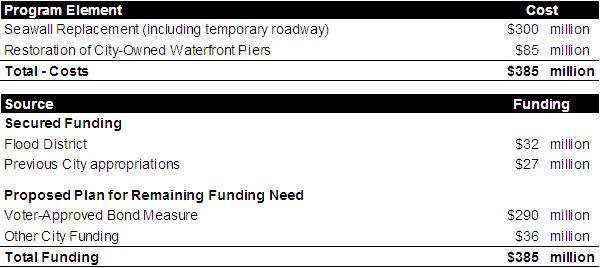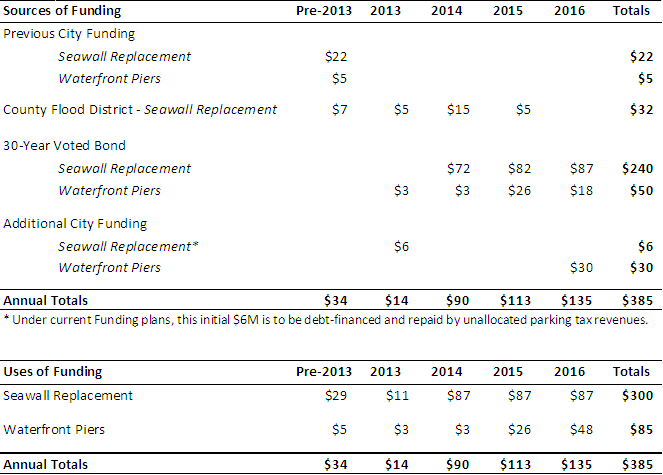Form revised April 10, 2010
2011-2012 BUDGET LEGISLATION FISCAL NOTE
|
Department: |
Contact Person/Phone: |
CBO Analyst/Phone: |
|
Legislative Department |
Ben Noble/684-8160 |
|
|
Legislation Title: AN ORDINANCE relating to the Alaskan Way Seawall Replacement Project; providing for the submission to the voters of the City, at an election to be held on November 6, 2012, of a proposition authorizing the City to issue general obligation bonds to pay costs related to the design, construction, renovation, improvement and replacement of the Alaskan Way seawall and associated public infrastructure; the principal of and interest on such bonds to be payable from annual property tax levies to be made in excess of regular property tax levies; and ratifying and confirming certain prior acts.
|
Summary of the Legislation: This legislation will submit to the voters of Seattle a proposal for a $290 million, 30-year bond measure and excess property tax levy for the purpose of replacing the Alaskan Way Seawall and associated public infrastructure, including City-owned waterfront piers. The authorized bond proceeds will be combined with other City resources to fund, over the next five years, replacement of the Alaskan Way Seawall and the rebuilding of Piers 58 and 62/63.
The costs of environmental, engineering, design, architectural, planning, consulting, permits, project management, construction, mitigation, inspection, testing, financial, legal, audit and other services lawfully incurred incident to the Project, costs of issuance and sale of the Bonds, administrative and relocation expenses and improvement, demolition, road improvements, special election costs, and “1% for Arts” allocation are all included as eligible expenses. To provide on-going accountability regarding the use of bond proceeds, the ordinance directs the City Auditor to provide an annual audit of project expenditures.
Background: The existing Alaskan Way Seawall was not designed to withstand earthquakes and has been structurally weakened due to tidal forces, aging materials and marine borer damage. There is a one in ten chance of an earthquake leading to liquefaction and seawall failure, within the next ten years. The failure of the seawall could disrupt public transportation and utilities, damage regional commerce and potentially lead to loss of life. In addition, Piers 58 and 62/63, which are publicly owned, have reached dangerous levels of deterioration. Pier 58 is seismically vulnerable, and Pier 62/63 is structurally compromised to the degree that limited physical activity is now permitted. Thus, timely restoration of these basic infrastructure elements is critical to protecting public safety and preserving the economic vitality of the local and regional economy. This legislation addresses these risks by providing a significant share of the overall funding required to complete this restoration work.
The table below summarizes the estimated project costs.
Estimated Costs of Seawall and Pier Replacement

Funding for the replacement of the Seawall and City-owned waterfront piers will come from a variety of sources. A portion of the funding has already been secured. As summarized in the table below, the proposed bond measure would address most of the unfunded gap, but some additional funding will be necessary in the future to complete the identified work.
Basic Waterfront Infrastructure: Funding Sources

When combined with the $59 million in secured funding, the proposed $290 million bond measure would provide $349 million of the required funding. This would then leave approximately $36 million of funding to be provided from other sources. Under existing plans, $6 million of this total will be financed from future commercial parking tax revenues; leaving a net need of $30 million. As shown in the cash-flow table provided in Attachment A, this $30 million will not be required until 2016, so the proposed bond measure does relieve short-term financial pressures on the City.
Councilmanic debt, with debt service to be paid from the General Fund, is the most obvious source for this last component of the required funding. A total of $30 million in debt would cost the City approximately $1.9 million in annual bond payments, assuming 30-year debt at 5% interest. A Local Improvement District (LID) is another potential source for the remaining funding. Formation of an LID is being considered as a primary funding source for waterfront improvements beyond the basic infrastructure identified here, but an LID might also contribute to basic pier restoration.
The annual debt service for the full amount of $290 million voter-approved is estimated to be $19 million per year over a 30-year period, assuming a 5% interest rate. Once the full $290 million in debt has been issued, the annual impact to property owners is projected to about $59 for a median-value home of approximately $360,000.
The property tax collections would begin in either 2013 or 2014, depending on when the first debt issuance occurred. Due to the timing of when tax assessments are calculated and processed, tax collections for bond payments cannot begin until the year following the first bond sale. Debt could initially be issued in late 2012 (assuming voter approval is granted in November), but the first issuance might not occur until 2013. Cash flow needs for the project are relatively modest in 2013 and may not justify the costs of a separate bond sale.
Further detail about the timing of the proposed bond funding as well as the projected cash flow for each of the other funding sources is provided in Attachment A.
__X__ This legislation has financial implications. (Please complete all relevant sections that follow.)
What is the financial cost of not implementing this legislation? Replacement of the Alaskan Way Seawall is a priority project. A failure of the seawall would impact property, transportation, commerce and most importantly endanger lives in the area. However, existing City revenues are insufficient to complete the seawall replacement. Without this legislation, alternative sources would need to be identified. Debt service costs on a Councilmanic issuance for the full $326 million funding gap would exceed $20 million per year. Redirecting existing General Fund resources to this purpose would force significant reductions in direct City services.
Does this legislation affect any departments besides the originating department? Yes. The Seattle Department of Transportation, the Department of Parks and Recreation, Seattle Public Utilities and City Light are all involved in the waterfront project. In addition, the ordinance calls on the City Auditor to perform (or have performed) an annual audit of project expenses.
What are the possible alternatives to the legislation that could achieve the same or similar objectives? The City could pursue a property tax levy lid lift to provide comparable funding for the seawall project. A lid lift, if used for paying debt service on bonds issued to finance the project, would be limited in term to 9 years and would require a higher tax rate and annual household cost relative to an excess levy supporting a 30 year bond measure. The lid lift would however, reduce the total cost to taxpayers due to reduced interest payments over the shorter term of the debt issuance.
Is the legislation subject to public hearing
requirements? No, a CLEAN hearing for the overall Alaskan Way Viaduct
& Seawall Replacement project has already been conducted.
Other Issues (including long-term implications of the legislation): None.
Please list attachments to the fiscal note below:
Attachment A – Seawall and Pier Replacement: Annual Costs and Projected Funding
Attachment A
Seawall and Pier Replacement: Annual Costs and Projected Funding ($ Millions)
